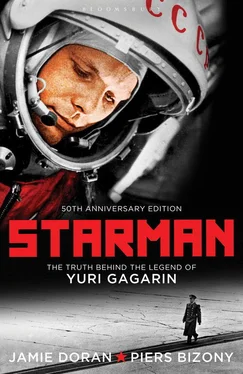We must be fully convinced that the flight will be a success. It will be more complicated than previous flights, and the preparation will have to be appropriately longer… We do not intend to rush our programme. Excessive haste leads to fatal accidents, as in the case of the three American astronauts last January. [4] Quoted in Oberg, Red Star in Orbit , pp. 90–91.
Kamanin’s anxiety presaged disaster. Alexei Leonov says, ‘The first manned test of the Soyuz was assigned to Vladimir Komarov, with Yuri Gagarin as the back-up, and another Soyuz spacecraft was being prepared for Yuri to fly at a later date. He trained very hard for two years, reporting the progress of his training in detail to the State Committee. Then Komarov flew for two days [specifically, 27 hours] and we had a big problem.’
Komarov’s launch was supposed to be followed a day later by another Soyuz with three more crewmen aboard: Valery Bykovsky, Yevgeny Khrunov and Alexei Yeliseyev. The two Soyuz ships were supposed to dock, then Khrunov and Yeliseyev were scheduled to spacewalk into Komarov’s capsule and sit in his spare seats, thus producing another world ‘first’ – going up in one ship and coming home in another. This was designed as a rehearsal for a future moon mission. The Soyuz did not yet include an airtight docking tunnel, so the only way of swapping a crewman between the capsule and a future lunar lander would be to spacewalk him from hatch to hatch.
It seems likely that the Brezhnev administration wanted the docking to take place on or around May Day. The year 1967 had a special significance in the communist calendar; it was the fiftieth Anniversary of the 1917 Revolution. The concept of making a ‘union’ between two spaceships collaborating in orbit was highly symbolic, especially for a ruling government obsessed with symbols. In 1982 Victor Yevsikov, an engineer on the Soyuz development team who helped design the heat-shield, admitted from his new safe haven in Canada that heavy political pressure was applied to Vasily Mishin and OKB-1 to get the two Soyuz ships into orbit on time:
Some launches were made almost exclusively for propaganda purposes. An example, timed to celebrate International Solidarity Day in 1967, was the ill-fated flight of Vladimir Komarov… The management of the OKB-1 Design Bureau knew that the Soyuz vehicle had not been completely debugged, and more time was needed to make it operational, but the Communist Party ordered the launch, despite the fact that four preliminary unmanned tests had revealed faults… The flight took place despite Vasily Mishin’s refusal to sign the endorsement papers for the Soyuz re-entry vehicle, which he considered unready. [5] Yevsikov, Victor, Re-entry Technology and the Soviet Space Programme: Some Personal Observations , Reston, VA: Delphic Associates, 1982, quoted in Oberg, Uncovering Soviet Disasters , p. 171.
As the deadline for the mission drew near, OKB-1 technicians knew of 203 separate faults in the spacecraft that still required attention. Yuri Gagarin was closely involved in this assessment. [6] Details of Gagarin’s involvement in the Soyuz technical assessment are confirmed by ex-KGB officer Venyamin Russayev, at the specific request of Valentina Gagarina.
By March 9, 1967, he and his closest cosmonaut colleagues had produced a formal ten-page document, with the help of the engineers, in which all the problems were outlined in detail. The trouble was, no one knew what to do with it. Within Soviet society, bad news always reflected badly on the messenger. Quite apart from Mishin, as many as fifty senior engineers knew about the report, or had helped draft it, but none of them felt sufficiently confident to go into the Kremlin and do what had to be done: request that Leonid Brezhnev play down the symbolism of the pending launch, so as to allow a decent delay for technical improvements.
The cosmonauts and space bureaucrats eventually adopted an age-old technique. They recruited a non-partisan messenger from outside the Soyuz programme to deliver the document for them: Yuri Gagarin’s KGB friend Venyamin Russayev.
‘Komarov invited me and my wife to visit his family,’ says Russayev. ‘Afterwards, as he was seeing us off, he said straight out, “I’m not going to make it back from this flight.” As I knew the state of affairs, I asked him, “If you’re so convinced you’re going to die, then why don’t you refuse the mission?” He answered, “If I don’t make this flight, they’ll send the back-up pilot instead. That’s Yura, and he’ll die instead of me. We’ve got to take care of him.”… Komarov said he knew what he was talking about, and he burst into such bitter tears. Of course he kept his emotions in check in front of his wife, but when we were alone for a moment he collapsed completely.’
Russayev could not be of much help on his own. Back at his desk in the Lubyanka the next morning, after a sleepless night, he decided to ask advice from one of his KGB seniors, Major-General Konstantin Makharov, a man he respected. ‘Makharov’s department dealt with space issues in relation to personnel. He used to work very closely with Korolev, but he was gone, and [his successor] Mishin wasn’t the same kind of man. The guys in my department also contributed to this work, but Mishin was impossible to deal with, particularly when firm decisions were required. He always needed a lot of guidance… I went to Makharov’s office and told him there was a serious problem with the rocket. He listened to me very carefully, and then he said, “I’m going to do something. In the meantime don’t leave your desk today. Not even for one second.” I kept my promise, and I’d only been back at my desk for a short while when he sent for me again. He gave me a letter, prepared by a team mobilized by Yuri Gagarin. Most of the cosmonauts took part in the research. Makharov told me to take the letter upstairs and see Ivan Fadyekin, Head of Department Three.’
This ‘letter’ consisted of a covering note, along with the ten-page document describing all 203 problems in the Soyuz hardware. Russayev insists, ‘I didn’t read it. I simply didn’t have the time.’ Just as likely, his instincts as a KGB man warned him that sneaking a look at the document might be very dangerous for him. As soon as he saw it, Fadyekin decided the same thing and dodged the responsibility straight away. ‘I don’t have the expertise for this.’ He redirected Russayev to a much more dangerous man in the Lubyanka: Georgi Tsinev.
Tsinev was a close personal friend of Leonid Brezhnev; in fact, he was related by marriage, and they had fought alongside each other in the war. If anyone could deliver an important message straight into the hands of the First Secretary, Tsinev could. Unfortunately for Russayev, things were not quite that simple. Tsinev was rising fast within the KGB, helped along by his powerful patron in the Kremlin. He was not going to allow any irritations to disturb that cosy relationship. ‘While reading the letter, Tsinev looked at me, gauging my reactions to see if I’d read it or not,’ Russayev explains. He had the inescapable feeling that Tsinev already knew the document thoroughly and was not remotely interested in its technical details. ‘He was glaring at me very intently, watching me like a hawk, and suddenly he asked, “How would you like a promotion up to my department?” He even offered me a better office.’
Russayev was now in great danger. Tsinev was trying to buy him off with a promotion, at the same time as placing him in a department where he could be more closely monitored. If Russayev accepted the deal, he would lose any chance of helping Komarov and Gagarin’s cause. On the other hand, if he rejected Tsinev’s offer, the consequences did not bear thinking about. ‘It was all part of the game, I suppose. I was very angry, but I couldn’t let it show. I declined Tsinev’s offer very carefully, explaining that I wasn’t really qualified for the work in his department.’
Читать дальше












